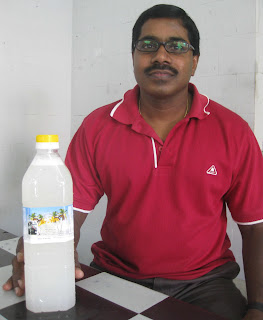 |
| Facade of JB Chinese Heritage Museum from Jalan Ibrahim |
A walk on Jalan Tan Hiok Nee will take you pass charming coffee shops, old provision stores, a traditional charcoal bakery and to OCBC Bank – the bank for Johor’s pioneer overseas Chinese.
It will also lead to the rear entrance of the Johor Baru Chinese Heritage Museum
A visit to the museum is an enriching experience not only for those who wish to learn more about the culture and heritage of their forefathers and early Chinese immigrants in Johor but also for everyone who is keen on history. Valuable artifacts, contributed by families, collectors, schools and associations, are carefully preserved here as a reliable source of information for the benefit of future generations. A great deal of thought and research has gone into organizing the layout for visitors to follow the sequence of events and better appreciate the history of the Chinese in Johor.
 |
| Early immigrants may have arrived with meagre possessions |
On the ground floor, read a brief chronology of history on a giant poster that spans the entire lobby wall. This brief overview outlines the sequence of historical events, carefully laid out in the museum. To save energy, lighting at every level is controlled by sensors that will respond when you step in and for your convenience, information throughout the museum is provided in three languages – Chinese, English and Malay.
Your tour of the museum is ingeniously designed in such a way that when you arrive at the top of the staircase to the first floor, it is as if you are stepping off a boat, just like the early immigrants. This scenario literally transports you to another era when immigrants stagger off the boat in a foreign land with a few humble possessions after braving a long and dangerous journey by sea in overcrowded and unhygienic conditions. For many, poverty, oppression and injustice may have driven them from China
Useful information is presented in a range of wall plaques and through interesting documentaries screened on large flat-screen TVs. Names like Tan Hiok Nee, Wong Ah Fook as well as Ngee Heng and Kangkar Tebrau will take on a new meaning as you understand the history of Chinese associations in Johor. In addition to learning about the early economic development of Johor through the cultivation of pepper and gambir, you can also gain further insight into the history of Chinese-Malay relationships that under girds the strong support between the Johor sultanate and the Chinese community today.
 |
| Samples of spices that brought traders to the East Indies |
The display also explores the development of the five individual clan associations for the Teochew, Cantonese, Hokkien, Hakka and Hainan dialects and their unique unity in the Johor Ancient Chinese Temple
A number of interesting and invaluable artifacts are displayed in the section on the Turbulent Times during the Japanese Occupation and the nation’s struggle for independence. This is where you can see a Japanese samurai sword and military beret that clearly represents the grief of a suffering Chinese community in this difficult era. Then look closer at samples of ancient documents like a Provisional Passport, a wedding certificate as well as a War Damage Claim!
 |
| Special exhibit on the life and achievements of Chinese revolutionary and political leader, Dr Sun Yat Sen |
The top floor of the museum currently features an exhibition on the life and achievements of Chinese revolutionary and political leader, Dr Sun Yat Sen. Visit this temporary exhibit to find the answer to this burning question: “Did Sun Yat Sen come to Johor Baru?” When this exhibition ends in March 2012, you can look forward to the next exhibit dedicated to the role of the Ngee Heng kongsi or association, in Johor’s history.
Before you leave, remember to sign the guest book at the ground floor lobby. This is an opportunity for you to pen your thoughts or comments and put on record that you were here. There are also forms for you to give any constructive feedback so that the curator can take the necessary action to improve the museum facilities.
The museum, located at 42, Jalan Ibrahim, Johor Bahru, is open daily from 9am to 5pm and closed on Monday. Opening hours are extended to 10pm when Tan Hiok Nee Heritage Walk comes alive with music and cultural attractions on Saturday evenings. Entrance fees are RM5 for adult and RM2 for students, children and senior citizens. Tel: 607 – 2249 633, Fax: 607 – 2249 635 or email: heritage_museumjb@jb-tionghua.org.my












































